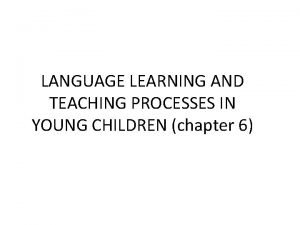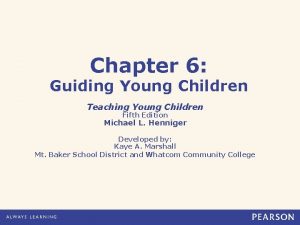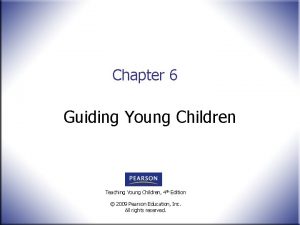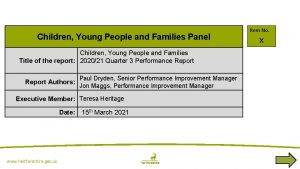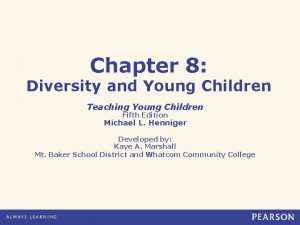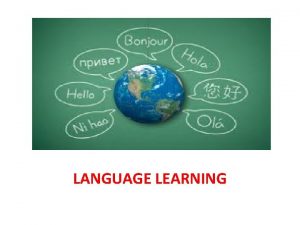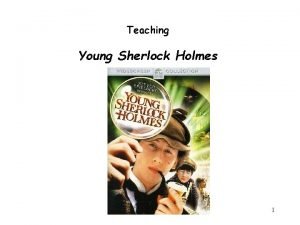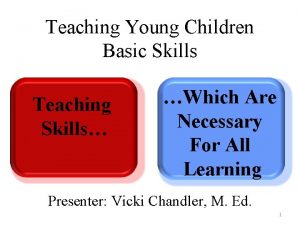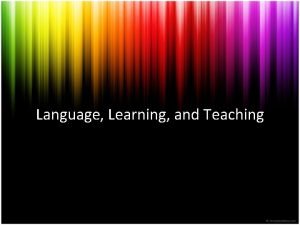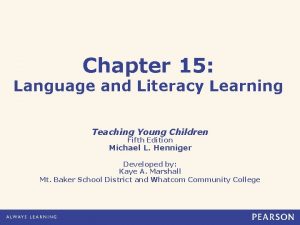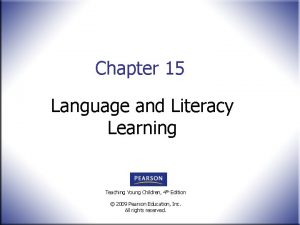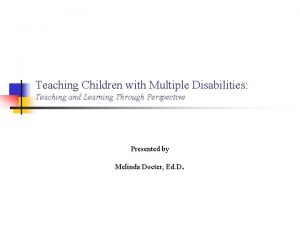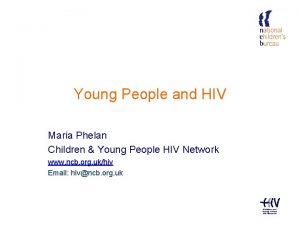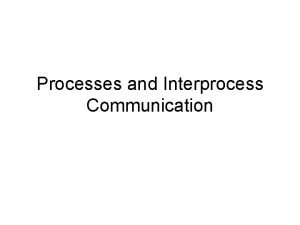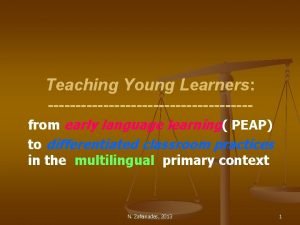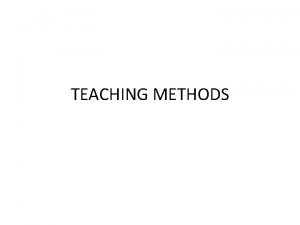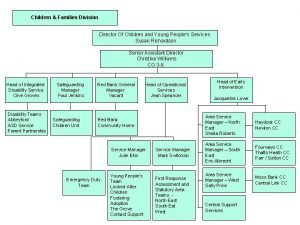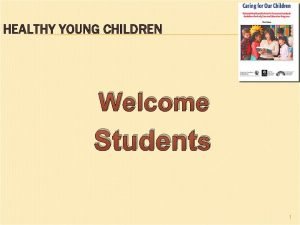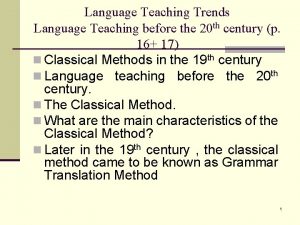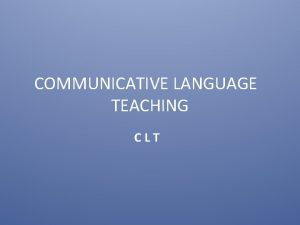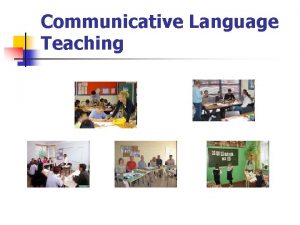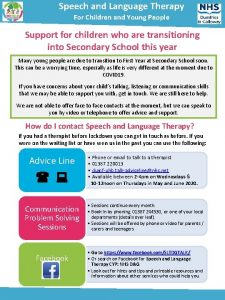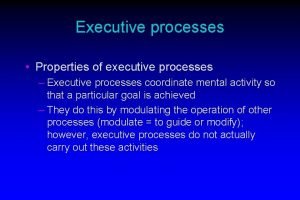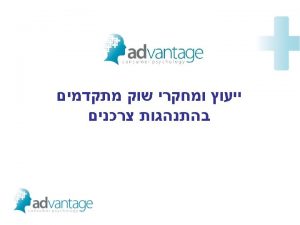LANGUAGE LEARNING AND TEACHING PROCESSES IN YOUNG CHILDREN
















































- Slides: 48

LANGUAGE LEARNING AND TEACHING PROCESSES IN YOUNG CHILDREN (chapter 6)

Power. Point Outline** • I. The Role of the Environment in Language Development • II. Cognition and Language • III. Toddler Learning Strategies • IV. Adult Conversational Learning Techniques • V. Print vs. E-Books for Young Children

I. THE ROLE OF THE ENVIRONMENT IN LANGUAGE DEVELOPMENT** • Development of language rests upon several major variables that interact with one another • 1. The child’s cultural and linguistic environment is a big influence upon language learning • 2. Each child has unique characteristics that she brings to the language learning situation

For a child to develop language optimally…** • She needs language stimulation from her environment • In many cultures, adult interaction with infants and young children differs from mainstream U. S. expectations

For example…** • Most American mothers use infantdirected speech: high pitch, shorter sentences, longer pauses, repetition • However, other cultures (e. g. , Native American) are silent with infants; children also may not be read to

In some cultures it is believed that…** • Children should be seen and not heard • Children learn by observation, not interaction • Comprehension is more important than production

Socioeconomic status makes a difference…** • Low-SES children’s vocabularies develop more slowly • Homelessness--very negative impact • Low-SES moms may not read as much • High levels of prohibitions (e. g. , “no!!” “don’t!”) result in poorer language skills for children

Mainstream Americans…** • View their children as conversational partners • Believe in playing with their children

However, in a 10/18 ASHA Leader article (October issue)** • There was an article entitled From Couching to Coaching • It was talking about what a lot of my former students have told me: when they do home visits for early language intervention, the parents sit on the couch on their phones and don’t want to be involved—they want the SLP alone to “fix it. ”

The question was: ** (p. 48 of 2018 article) • How do we get families off the couch and working with us on improving the child’s communication during mealtimes, toothbrushing, and other daily routines?

ASHA Leader article —why parents disengage:

ASHA Leader article suggestions:

ASHA Leader article:

ASHA Leader article—coaching the parent involves:

II. COGNITION AND LANGUAGE** • Cognition and language are intertwined and develop in parallel fashion • Cognitive skills are especially related to grammatical constructions like because and before & after

Word acquisition is guided by 2 types of knowledge structures** • Event-based knowledge: sequences of events or routines that are temporal or causal and organized toward a goal

A child uses this event-based knowledge to form scripts** For example, if a child goes to daycare, takes swimming lessons, or goes to Sunday school, she has knowledge of those events —they are a script for her Preschoolers especially rely on this type of knowledge

Taxonomic knowledge:

III. TODDLER LEARNING STRATEGIES** • A. Formula • Verbal routine or unanalyzed chunk of language—memorized units often used in everyday conversation • Mark Mc. Kibbin at 2 years old: “Thanks, and have a nice day!”

• B. Selective Imitation** • Toddlers imitate a part of or all of an utterance • Used in the acquisition of words, morphology, and syntactic-semantic structures • Cute funny baby imitating his father (motions only)

• C. Evocative Utterance** • Child names entities; makes a statement • “Car. ” • Adult gives evaluative feedback that confirms or negates what the child said • Child then maintains or modifies meaning

• D. Interrogative Utterance** • The child is unsure of the word, and asks “what’s that? ” • They are requesting information

IV. ADULT CONVERSATIONAL TEACHING TECHNIQUES** • A. General Facts • Children learn language faster when parents converse (as opposed to teaching and instructing) • There are definite language-learning advantages for children who attend preschools where the curriculum emphasizes language and literacy

B. Expansions and Extensions** • 1. Expansion: more mature version of the child’s utterance in which word order is preserved • Ch: “Daddy drive. ” • Adult: “Daddy is driving. ”

• 2. Extension:

C. Turnabouts** • Utterance that both responds to the previous utterance and, in turn, requires a response • Ch: We went to the zoo! • Dad: Zoos are fun. What animals did you see?

Types of turnabouts are in Table 6. 6 on p. 177— just know these: ** • Fill-ins (My dog likes to _______) • Wh-questions (Why does the dog scratch himself? When do we eat breakfast? ) • Yes-no questions (Do you think the dog has fleas? )

Summary of new research on child-directed speech:


The more TV in a child’s day…** • The lower her language scores

**Christakis and colleagues studied the impact of TV and its noise on parent-child interactions in homes

Christakis et al. found that:

Constant noise in the home is also associated with:

Devices like phones make a difference too: ** • More people on earth own a mobile device than a toothbrush • The average person has a 7 -second attention span; a goldfish has an 8 second span

ASHA Leader July, 2019:

V. PRINT VS. E-BOOKS FOR PRESCHOOLERS** • A. Premise • The American Academy of Pediatricians (2020) clearly states little-no screen time for children from 0 -2 years, except for video chatting with relatives • Research shows that school-aged children may benefit from e-book advantages (e. g. , dictionaries, highlighting key words)

In terms of paper vs. e-books for preschool children (2 -5 years)** • Research is mixed • E-books--more exciting, initially engage children’s attention more effectively than paper books

But…. ** • What is their effect on dialogic reading and children’s comprehension? • Dialogic reading: interactive reading between caregivers and children

Disadvantages: (Willoughby, Evans, & Nowak http: //www. eetconference. org/wpcontent-uploads/

Parrish-Morris, Mahajan, Hirsh-Pasek, Golinkoff, & Collins (2013). Once upon a time: Parent-child dialogue and storybook reading in the electronic era. Mind, Brain, and Education, 7(3), 200 -211. ** • Studied 165 parent-child dyads reading ebooks and traditional paper books • Children’s story comprehension and parentchild dialogic reading were negatively affected by the presence of electronic features

Parrish-Morris et al. continued:

ASHA Leader June 2019: ** • Cited a study done at University of Michigan Children’s Hospital • bit. ly/print-books

ASHA Leader June 2019** • Recorded videos of parents reading to toddlers in 3 conditions: • 1. Basic e-book (no sound effects or hot spots) • 2. Enhanced e-books (e. g. , with sound, animation) • 3. Print books

ASHA Leader article 2019—Number of children’s verbalizations during reading

Dr. Perri Klass: Journal of the American Medical Association, parents and ch 10 -16 months of age

Ma et al. , American Academy of Pediatricians:

Nbcnews. com 2020:

Power. Point Outline • I. The Role of the Environment in Language Development • II. Cognition and Language • III. Toddler Learning Strategies • IV. Adult Conversational Learning Techniques • V. Print vs. E-Books for Young Children
 Concurrent in os
Concurrent in os Unit 10 caring for children and young people
Unit 10 caring for children and young people Working with young children chapter 1
Working with young children chapter 1 Trauma symptom checklist for young children
Trauma symptom checklist for young children Phonemic awareness in young children
Phonemic awareness in young children Hampshire early years moodle
Hampshire early years moodle Alcohol consumption causes blood vessels to contract.
Alcohol consumption causes blood vessels to contract. Teaching children joy
Teaching children joy Scaled down teaching
Scaled down teaching Cuadro comparativo de e-learning
Cuadro comparativo de e-learning How to teach grammar to young learners
How to teach grammar to young learners Teaching young learners english
Teaching young learners english Corso di laurea in scienze della formazione primaria
Corso di laurea in scienze della formazione primaria Young and dyslexic poem
Young and dyslexic poem Comprehensible input
Comprehensible input Child development chapter 1
Child development chapter 1 Chapter 1 early learning
Chapter 1 early learning Lev in significant cigarettes
Lev in significant cigarettes Cognitive and appetitive faculties of the learner
Cognitive and appetitive faculties of the learner New jersey center for teaching and learning
New jersey center for teaching and learning How many total squares are there
How many total squares are there Guiding principles for teaching and learning in mtb-mle
Guiding principles for teaching and learning in mtb-mle Teaching and learning framework lausd
Teaching and learning framework lausd Assessment the bridge between teaching and learning
Assessment the bridge between teaching and learning Technical core: teaching and learning
Technical core: teaching and learning Audio learning resources
Audio learning resources Ib approaches to teaching and learning ppt
Ib approaches to teaching and learning ppt Www.njctl.org answer key
Www.njctl.org answer key 10 steps to independence daily 5
10 steps to independence daily 5 Advantages and disadvantages of assure model
Advantages and disadvantages of assure model What is contextualized teaching and learning
What is contextualized teaching and learning Transparency in learning and teaching
Transparency in learning and teaching Nj center for teaching and learning
Nj center for teaching and learning Contextual teaching and learning
Contextual teaching and learning Three types of learning
Three types of learning Taylor institute for teaching and learning
Taylor institute for teaching and learning Desuggestopedia principles
Desuggestopedia principles Bottom up and top down approach in teaching
Bottom up and top down approach in teaching History of curriculum
History of curriculum Aims and objectives of language teaching
Aims and objectives of language teaching Young goodman brown literary devices
Young goodman brown literary devices Great teaching inspired learning
Great teaching inspired learning Development of teaching learning materials
Development of teaching learning materials Peek model for readiness to learn
Peek model for readiness to learn![Creative teaching u0026 learning [open house sit lhi] Creative teaching u0026 learning [open house sit lhi]](data:image/svg+xml,%3Csvg%20xmlns=%22http://www.w3.org/2000/svg%22%20viewBox=%220%200%20200%20200%22%3E%3C/svg%3E) Creative teaching u0026 learning [open house sit lhi]
Creative teaching u0026 learning [open house sit lhi] Inductive and analytical learning in machine learning
Inductive and analytical learning in machine learning Difference between inductive and analytical learning
Difference between inductive and analytical learning Lazy learning and eager learning
Lazy learning and eager learning Tony wagner's seven survival skills
Tony wagner's seven survival skills

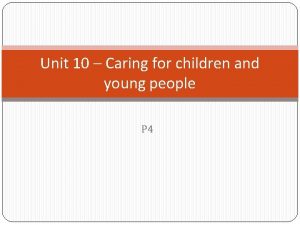
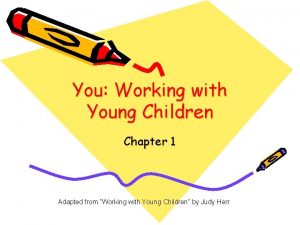
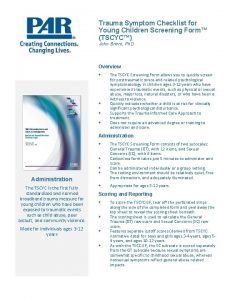



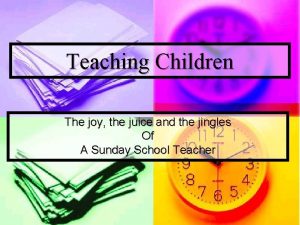





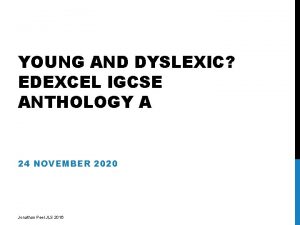

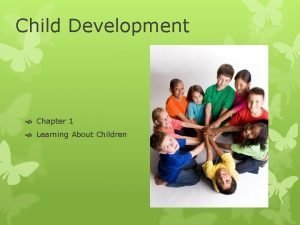
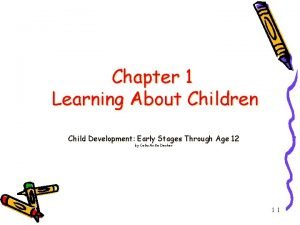
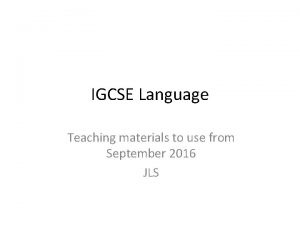
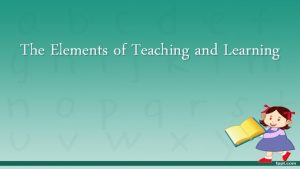
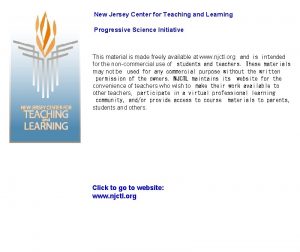
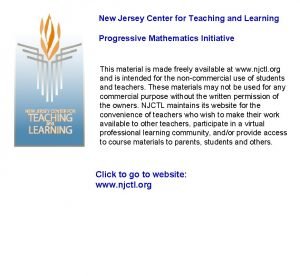

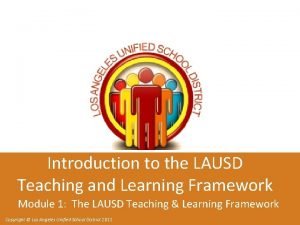
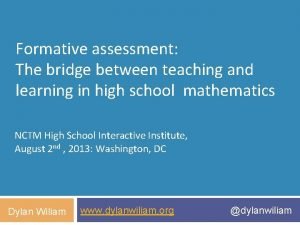
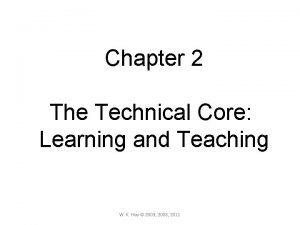
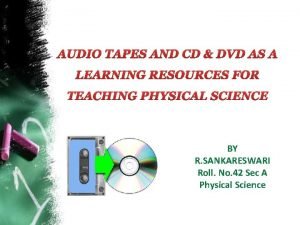
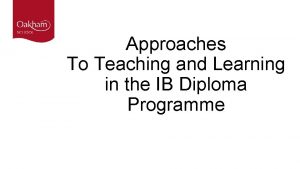
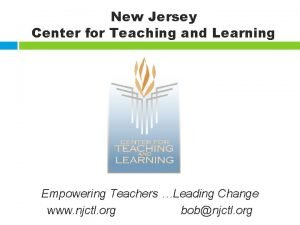
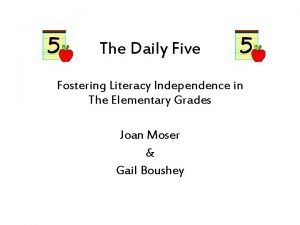

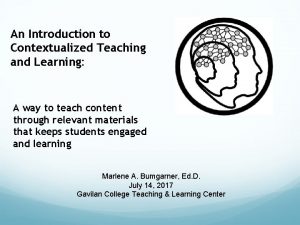
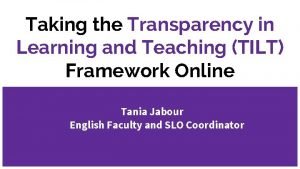
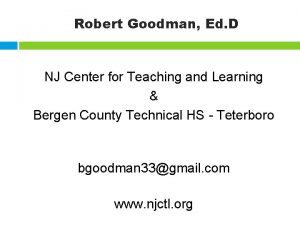
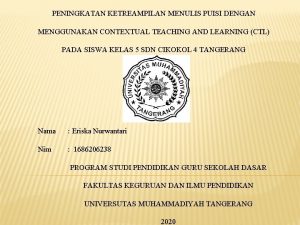
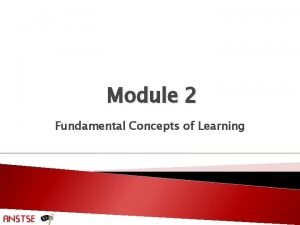
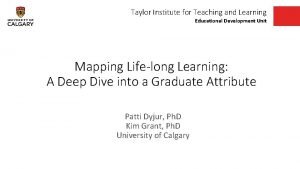
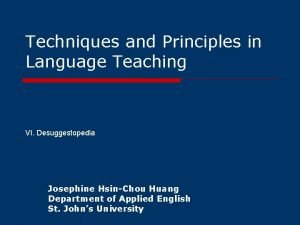
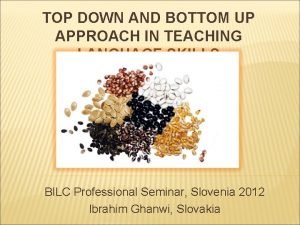
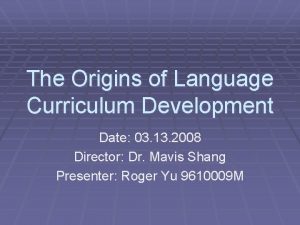
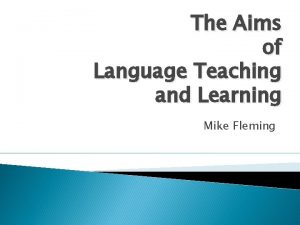

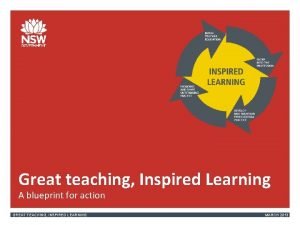

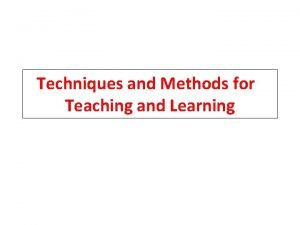
![Creative teaching u0026 learning [open house sit lhi] Creative teaching u0026 learning [open house sit lhi]](https://slidetodoc.com/wp-content/uploads/2020/11/2512431_988e0f6fb16141d8d362e3669c9f87c2-300x225.jpg)




